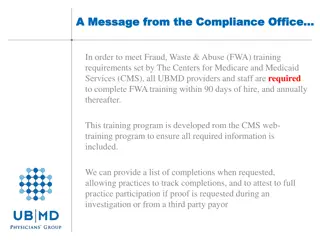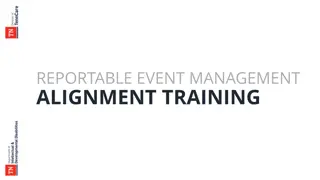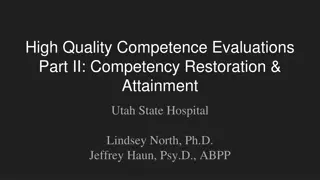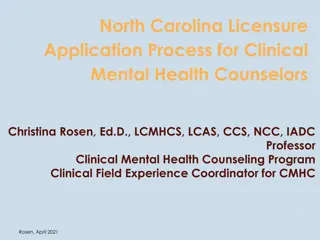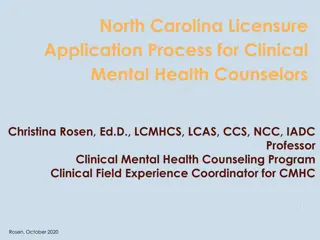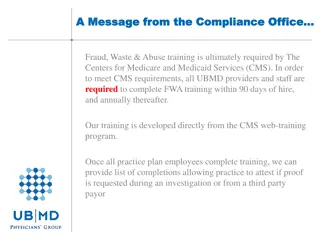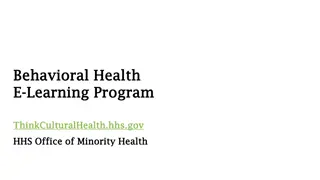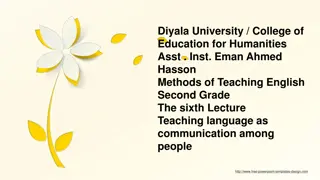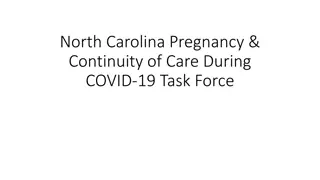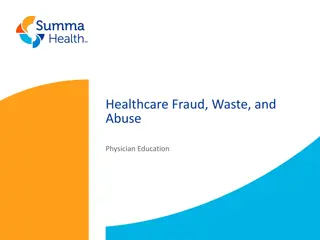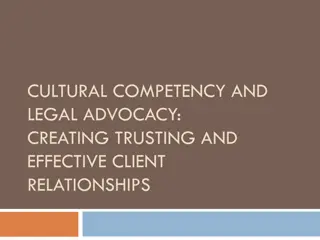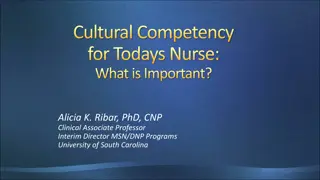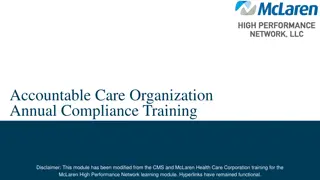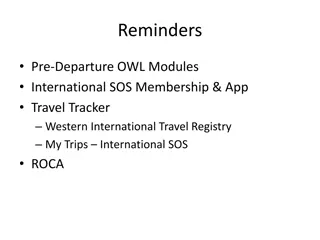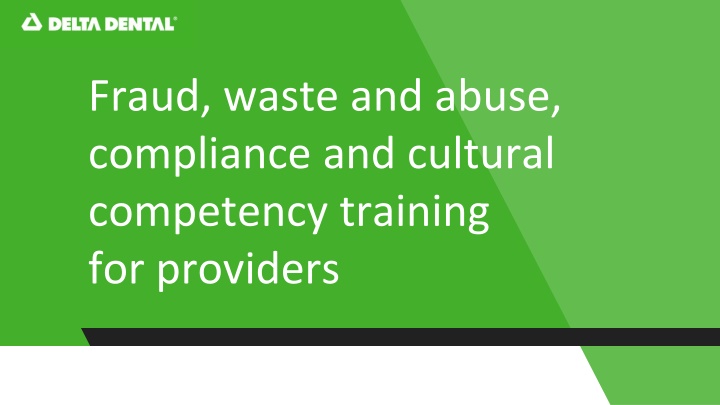
Fraud, Waste, and Abuse in Health Care Industry
Learn about fraud, waste, and abuse in the health care industry and how they impact providers. Gain insights into the False Claims Act and the importance of compliance training. Explore real-world examples and figures related to health care fraud cases.
Download Presentation

Please find below an Image/Link to download the presentation.
The content on the website is provided AS IS for your information and personal use only. It may not be sold, licensed, or shared on other websites without obtaining consent from the author. If you encounter any issues during the download, it is possible that the publisher has removed the file from their server.
You are allowed to download the files provided on this website for personal or commercial use, subject to the condition that they are used lawfully. All files are the property of their respective owners.
The content on the website is provided AS IS for your information and personal use only. It may not be sold, licensed, or shared on other websites without obtaining consent from the author.
E N D
Presentation Transcript
Fraud, waste and abuse, compliance and cultural competency training for providers
Section 1: Fraud, waste and abuse (FWA)
3 What is fraud? Fraud is any activity defined by an intent to deceive on the part of a member, provider or client, a third-party biller, or even a payor, with the purpose of receiving an improper benefit. In order to be considered fraud, the act must be done knowingly, willfully and intentionally.
4 What is waste? Waste occurs from practices that result in unnecessary costs.
5 What is abuse? Abuse is very similar to fraud but occurs when a provider s practices are not consistent with sound fiscal, business or medical/dental practices, but unlike fraud, may not involve acts that are done intentionally.
6 FWA in the health care industry Across the board, politicians agree that fighting health care fraud is a profitable business. Between 2018 2020, the Department of Justice indicates there was $9.68 billion in alleged loss due to health care fraud. In 2020, the Department of Justice received $1.8 billion in health care fraud judgments and settlements. In 2020, the Department of Justice Health Care Fraud Unit charged 167 individuals, totaling $3.77 billion in alleged fraud loss, and convicted 144 individuals. DOJ Fraud Section Year in Review - 2020
7 FWA is important to participating providers Delta Dental administers government programs in the following states: Michigan Indiana Medicare Advantage Medicaid Healthy Kids Dental Healthy Michigan Plan Pregnant Woman Dental Medicare/Medicaid plans Medicare Advantage Ohio Medicare Advantage North Carolina Medicare Advantage
8 What is the False Claims Act? The False Claims Act establishes liability for damages for those who knowingly submitting a false or fraudulent claim to the government for payment. Knowingly means actual knowledge, deliberate ignorance and/or reckless disregard. A simple error is not enough; intent is generally required. However, failing to follow procedures, or failing to question something that doesn t seem right, may be found to be deliberate ignorance or reckless disregard. As a provider to Medicare Advantage and Medicaid beneficiaries, the false claims act may apply to claims submitted to Delta Dental under these programs.
9 False Claims Act Examples of false claims: Submitting false information or documents to the government This includes requests for proposals A dental group paid $5.1 million to settle a case that they: Upcoded simple tooth extractions (D7140) and improperly billed surgical extractions (D7210) Improperly billed for scale and root planing (deep cleaning) when they were either not performed or not medically necessary Falsifying dates of service and provider credentials
10 What is the Anti-Kickback Statute? The Anti-Kickback Statute prohibits knowingly and willfully offering, paying, soliciting or receiving anything of value, directly or indirectly, in return for referrals or to induce referrals for services for which payment may ultimately be made in part under a federal health care program.
11 Anti-Kickback Statute Claims that are submitted as a result of a violation of the Anti-Kickback Statute may be subject to the False Claims Act. Example of the Anti-Kickback Statute: Michigan Attorney General Dana Nessel charged the owner of a home help services business with three felony counts of Medicaid fraud-kickbacks. The owner of this particular home help services business worked with an independent living services specialist of the Michigan Department of Health and Human Services that was steering many clients to the home help service business, which in turn resulted in the state making significant payments to this business. Both the owner of the business and the employee of the State of Michigan co-managed the home help services business bank account, withdrawing thousands of dollars from the account for personal use. The owner is facing Medicaid fraud charges that are punishable by up to four years in prison and/or a $30,000 fine.
12 What is unlawful patient inducement? Unlawful patient inducement is similar to the prohibitions of the Anti-Kickback Statute and is unlawful in some situations to provide gifts (remuneration), or free items or services, to induce beneficiaries to receive services from your office that are reimbursable by a federal health care program. Exception: Items and services of a nominal value less than $15, and less than $75 per year
13 Unlawful patient inducement Example of unlawful patient inducement: An employee of a hospital that is responsible for granting contracts to suppliers who billed government programs (like Medicare and Medicaid) received expensive gifts, free trips and consulting fees from a supplier so that the employee would grant the contract to the supplier. Not only was this likely in violation of the hospital s code of conduct, these actions were prosecuted under the Anti-Kickback Statute.
14 Penalties associated with violating laws Penalties for individuals and/or entities that violate the previously mentioned laws: Civil lawsuits and monetary penalties Criminal prosecution and monetary penalties Treble damages (three times the actual damages) Suspension or exclusion from participation in the Medicare and Medicaid programs Penalties for network providers Providers can also face the termination of their provider agreement Loss or suspension of license
15 Delta Dental s Anti-fraud efforts Delta Dental monitors, detects and investigates FWA, and has a specific department that educates, detects, corrects, prevents, reports and deters insurance FWA. As an administrator of dental benefits, Delta Dental has a responsibility to ensure claims are paid accurately. This is accomplished by review, analysis and investigation of suspicious claims and investigations from members, clients, dental offices, employees and others to ensure that benefits are administered in accordance with all applicable contract, policies and regulations.
Section 2: Compliance
17 What is a compliance program? A compliance program is a platform used to facilitate compliance with the rules, regulations, contractual requirements and internal policies and procedures. A compliance program ensures guidance is provided on how to identify and report compliance violations.
18 What is an effective compliance program? Written policies and procedures Prompt response and prevention Delta Dental and you, as a network provider, are required to maintain a compliance program that prevents and detects fraud, and promotes an ethical culture. Fostering a culture focused on compliance not only reduces legal complications, but also improves operational efficiencies. Delta Delta network providers have a duty to understand regulatory standards that are applicable to them, including a duty to report potential violations when they occur. Enforcement of disciplinary guidelines Key elements of an effective compliance program Appropriate oversight Internal monitoring and auditing Effective training and education Effective lines of communication
19 Endorsing a culture of compliance Delta Dental s network providers are expected to endorse a culture of compliance. Detect and report If potential noncompliance is detected, report it! Prevent Operate within our compliance expectations Correct Implement corrective action for noncompliance Compliance is everyone s responsibility!
20 Seven core elements to an effective compliance program Written policies, procedures and standards of conduct Compliance oversight and leadership Effective lines of communication Effective training and education Well-publicized guidelines for noncompliance Internal monitoring and auditing Prompt response and corrective action
21 Seven core elements to an effective compliance program Written policies, procedures and standards of conduct These articulate your commitment to comply with all applicable federal and state standards, and describe compliance expectations. Compliance officer, compliance committee and high-level oversight Designate a compliance officer and a compliance committee accountable and responsible for the activities and status of the compliance program, including issues identified, investigated and resolved by the compliance program. Effective training and education This covers the elements of the compliance plan as well as preventing, detecting and reporting FWA.
22 Seven Core Elements to an Effective Compliance Program Effective lines of communication Network providers must have effective lines of communication accessible to ensure confidentiality and provide methods for anonymous and good-faith reporting. Well-publicized disciplinary standards Network providers must enforce standards through well-publicized disciplinary guidelines.
23 Seven core elements to an effective compliance program Effective system for routine monitoring, auditing and identifying compliance risks Network providers must monitor and audit its operations to evaluate compliance with all applicable requirements as well as the overall effectiveness of their compliance program. Procedures and system for prompt response to compliance issues Providers must use effective measures to respond promptly to noncompliance incidents and undertake appropriate corrective action.
24 What is noncompliance? Noncompliance is conduct that does not comply with the law, federal or state health care program requirements, or to your participation agreement with Delta Dental.
25 Upcoding Fraud, waste and abuse Noncompliance Unbundling claims Failing to fully and honestly cooperate in investigations Waiving copays for patient appointments Neglect Paying or accepting a referral fee for any federal or state health care program patient referral
26 How do I report suspected fraudulent activity? If you are aware of any false information submitted to Delta Dental, please call our toll-free anti-fraud hotline at 800-524-0147. You do not need to identify yourself. Delta Dental will not retaliate against you for disclosing or reporting suspected activity in good faith.
Section 3: Culturally and linguistically appropriate services (CLAS)
28 CLAS Standards overview The National CLAS Standards are a group of 15 separate guidelines that establish a blueprint for health and health care organizations. Principle standard Provide effective, equitable, understandable, and respectful quality care and services that are responsive to diverse cultural health beliefs and practices, preferred languages, health literacy and other communication needs. Advance health equity Help eliminate disparities Improve quality of services
The goal: Health equity The goal: Health equity, the attainment of the highest level of health for all people. The barriers: Currently, individuals across the United States from various cultural backgrounds are unable to attain their highest level of health for many reasons. One of the most modifiable barriers to health equity is the lack of CLAS. The tools: Cultural competency and linguistic competency.
30 What is cultural competency? Cultural competency is a lifelong learning process of increasing awareness, knowledge and skills, which refers to the ongoing and intentional attainment of skills that allow an individual to function effectively when interacting with people who have different backgrounds and experiences. Valuing, embracing and implementing cultural competency and diversity.
31 What is the goal of cultural competency? The goal of cultural competency is not to change your core values or beliefs, but rather to provide you with the skills needed to work with and assist people who may have different life perspectives than you. People who are well-versed in cultural competency are able to better assist Delta Dental s members, while at the same time maintaining their own personal identities.
32 Tool 1: Cultural competency Awareness of your own culture Self- knowledge increases your sensitivity to differences. Recognizing your own cultural uniqueness, and how that impacts your daily life, allows you to see the cultural uniqueness in others. Learn to accept differences Acceptance does not mean changing the way you see the world. Acceptance means understanding that other people may view the world differently than you do and being welcoming and accepting of people in light of those differences. Seek to understand the history and experience of others Know and learn the history of others. Know your stereotypes and biases Knowledge and acceptance of personal stereotypes and biases reduces the likelihood of their use. Recognize barriers to care In some instances, individuals may not seek services due to their background and/or beliefs.
Barrier 1: Racial and ethnic minorities Total minority population: 29.9% North Carolina population (2021) Black/African American (22.3%) Asian American (3.4%) Two or More Races (2.5%) American Indian/Alaska Native (1.6%) Native Hawaiian/Other Pacific Islander (0.1%) White (70.1%) Note: Data from the 2021 American Community Survey, United States Census Bureau. Chart numbers may not add to 100 percent due to rounding.
Barrier 2: Cultural beliefs Examples of cultural beliefs: In some cultures, people believe that talking about a possible poor health outcome will cause that outcome to occur. Among some Asian individuals, there is the belief that illness in the body needs to be drawn out, which may be achieved by vigorously rubbing the body with a coin or other metal object.
Barrier 3: Religious beliefs Examples of religious faith and spiritual beliefs: Among many individuals from Central America, the Mediterranean, parts of Asia, the Middle East and parts of Africa, there is the belief that illness is caused by an evil eye or curse, usually issued by someone who is envious of the cursed individual. Among some American Muslims, there is the belief that God controls illness and healing, and that healing is achieved through religious activity (e.g., prayer, religious rituals) in addition to the use of technology, medicine, social services, etc.
Barrier 4: Limited English proficiency Percent of North Carolina population speaking English less than very well Language Spoken at home North Carolina 2021 37.6 percent of the population that speaks languages other than English at home also reports that they do not speak English very well. Thus, 4.4 percent of the total population is Limited English Proficient (LEP). LEP 4.4% LEP refers to any person five years or older who reports speaking English less than very well. English only (88.2%) Languages other than English (11.8%) Note: Data from the 2021 American Community Survey, United States Census Bureau. Chart numbers may not add to 100 percent due to rounding.
37 What is health literacy? Health literacy is defined as the degree to which individuals have the capacity to obtain, process and understand basic health information and services needed to make appropriate health decisions.
Barrier 5: Low health literacy Without adequate health literacy, a patient may have trouble with the following tasks: Understanding written information and forms Understanding follow-up care and instructions Considering the risks and benefits of a dental procedure Scheduling an appointment
39 What is linguistic competency? Linguistic competency is the ability to communicate effectively with patients at every point of contact. Effective communication includes providing information, whether verbal, nonverbal or written, in a way that individuals from culturally diverse groups can easily understand.
Verbal communication By asking the patient what is meant by terms they use and checking in to make sure terms you use are understood. You can help the patient communicate more openly with you and react honestly to the information you provide. And provide a higher quality care that leaves your patient satisfied.
Nonverbal communication Eye contact or physical touch: May be expected in some cultures and inappropriate or offensive in others. Communication style: Loud speech with facial expressions or gesturing may be expected or may be perceived as impolite. Personal space: Individuals may stand very close when speaking or interpret this as being aggressive.
Written communication Written materials and forms: Communication through written language is just as important as verbal and nonverbal communication since it is one of the ways that critical information is shared and reinforced.
Language assistance An interpreter communicates a message, either spoken or signed in one language, into a second language, and abides by a code of professional ethics. Interpreters bridge the communication gap between you and your patients who do not share a common language. Using untrained individuals or minors (children interpreting for their parents) is discouraged. Speak directly to the patient, not the interpreter. Don t rush. Pause every sentence or two for interpretation.
Want to know more? Cultural Competency for Oral Health Providers Think Cultural Health (www.hhs.gov) www.thinkculturalhealth.hhs.gov/education/oral-health-providers 2018 North Carolina Health Equity Report https://schs.dph.ncdhhs.gov/SCHS/pdf/MinorityHealthReport_Web_2018.pdf
Section 4: Governance, leadership and workforce standards Guidance for promoting CLAS through policy, practices and allocated resources Governance | Leadership | Workforce
Governance, leadership and workforce standards Advance and sustain organizational governance and leadership that promotes CLAS and health equity through policy, practices and allocated resources. Recruit, promote and support a culturally and linguistically diverse governance, leadership and workforce that are responsive to the population in the service area. Educate and train governance, leadership and workforce in culturally and linguistically appropriate policies and practices on an ongoing basis.
Communication and language assistance standards Offer language assistance to individuals who have limited English proficiency and/or other communication needs, at no cost to them, to facilitate timely access to all health care and services. Inform all individuals of the availability of language assistance services clearly and in their preferred language, verbally and in writing. Ensure the competence of individuals providing language assistance, recognizing that the use of untrained individuals and/or minors as interpreters should be avoided. Provide easy-to-understand print and multimedia materials and signage in the languages commonly used by the populations in the service area.
Engagement, continuous improvement and accountability standards Establish culturally and linguistically appropriate goals, policies and management accountability, and infuse them throughout the organization s planning and operations. Conduct ongoing assessments of the organization s CLAS-related activities and integrate CLAS-related measures into measurement and continuous quality improvement activities. Collect and maintain accurate and reliable demographic data to monitor and evaluate the impact of CLAS on health equity and outcomes and to inform service delivery.
Thank you for reviewing Delta Dentals fraud, waste and abuse, compliance and cultural competency training slides. Please submit the Training Acknowledgement Attestation to be marked complete for this year.



